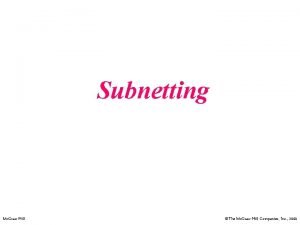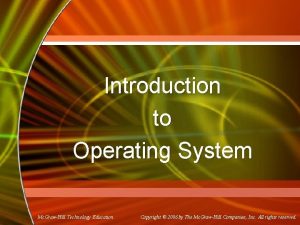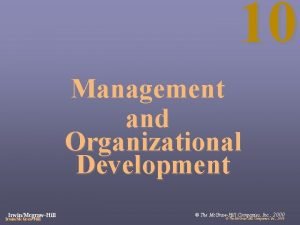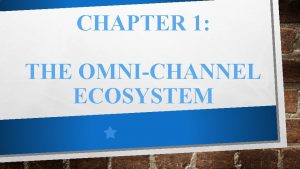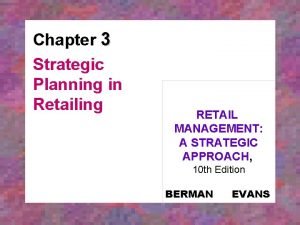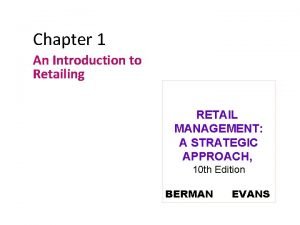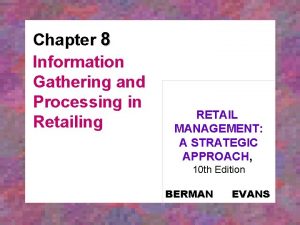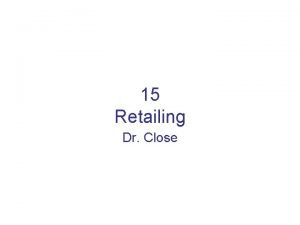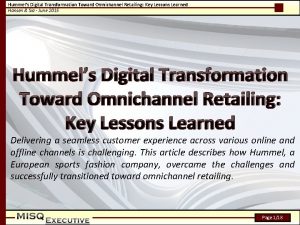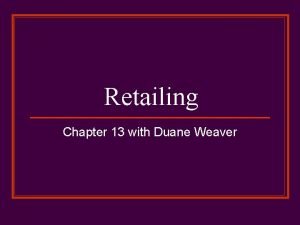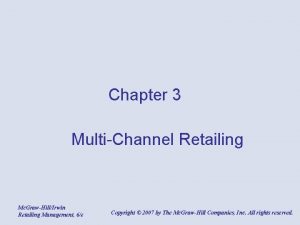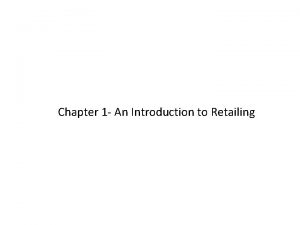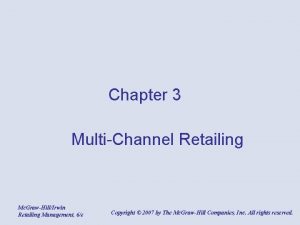Chapter 17 Retailing and Omnichannel Marketing Mc GrawHill






















- Slides: 22

Chapter 17 Retailing and Omnichannel Marketing ©Mc. Graw-Hill Education. All rights reserved. Authorized only for instructor use in the classroom. No reproduction or further distribution permitted without the prior written consent of Mc. Graw-Hill Education.

Learning Objectives Learning Objective 17. 1 Discuss the four factors manufacturers should consider as they develop their strategies for working with retailers. Learning Objective 17. 2 Outline the considerations associated with choosing retail partners. Learning Objective 17. 3 List the three levels of distribution intensity. Learning Objective 17. 4 Describe the various types of retailers. Learning Objective 17. 5 Describe the components of a retail strategy. Learning Objective 17. 6 Identify the benefits and challenges of omnichannel retailing. . 2 © Mc. Graw-Hill Education

Factors for Establishing a Relationship with Retailers © Mc. Graw-Hill Education Jump to Appendix 1 long image description 3

Choosing Retail Partners Channel Structure Degree of vertical integration Manufacturers’ brand Power of manufacturer and retailer 4 © Mc. Graw-Hill Education

Choosing Retail Partners Customer Expectations © Mc. Graw-Hill Education Jump to Appendix 2 long image description 5

Choosing Retail Partners Channel Member Characteristics Larger firms Less likely to use supply chain intermediaries Can gain more control, be more efficient, and save money 6 © Mc. Graw-Hill Education

Choosing Retail Partners Distribution Intensity Intensive Exclusive Selective 7 © Mc. Graw-Hill Education © Susan Van Etten/Photo. Edit

CHECK YOURSELF (1 of 3) 1. What issues should manufacturers consider when choosing retail partners? 2. What are the differences among intensive, exclusive, and selective levels of distribution intensity? 8 © Mc. Graw-Hill Education

Types of Retailers © Mc. Graw-Hill Education Jump to Appendix 3 long image description 9

Food Retailers Supermarket Limited nonfood Differentiates different types of foods Supercenter Warehouse Club Convenience Store Includes discount store Limited assortment Limited variety Walmart, Meijer, K-Mart, Target Little service Includes: Costco, Sams, BJ’s Good locations Peapod © Mc. Graw-Hill Education 10

General Merchandise Retailers Department Stores Full-line Discount Specialty Drugstores Category Specialist Extreme value Off-Price Broad variety and deep assortment Broad variety at low prices Limited merchandise with service in small store Specialty for pharmaceutical and heath Discount with narrow but deep assortment Full line, limited, very low prices Inconsistent assortment of brand-name merchandise at low prices 11 © Mc. Graw-Hill Education

Services Retailers Firms that primarily sell services rather than merchandise are a large and growing part of the retail industry. 12 © Mc. Graw-Hill Education

PROGRESS CHECK (2 of 3) 1. What strategies distinguish the different types of food retailers? 2. What strategies distinguish the different types of general merchandise retailers? 3. Are organizations that provide services to consumers retailers? 13 © Mc. Graw-Hill Education

Developing a Retail Strategy Using the Four Ps: Product Providing the right mix of merchandise and services that satisfies the needs of the target market 14 © Mc. Graw-Hill Education

Price defines the value of both the merchandise and the service provided. Walmart’s Profits Drop 15 © Mc. Graw-Hill Education Courtesy DDB - London

Promotion Retailers use a wide variety of promotions, both within their retail environment and through mass media. 16 © Mc. Graw-Hill Education AP Photo/Mark. Humphrey

Place Convenience is a key ingredient to success. 17 © Mc. Graw-Hill Education Photo 1: ©M Hruby, Photo 2: The Mc. Graw-Hill Companies, Inc/ Jill Braaten, photographer

Benefits of Stores for Consumers Browsing Touching and Feeling Personal Service Cash and Credit Entertainment and Social Interaction Instant Gratification Risk Reduction 18 © Mc. Graw-Hill Education

Benefits of the Internet and Omnichannel Retailing Deeper and Broader Selection Personalization • Gain Insights into Consumer Shopping Behavior • Increase Customer Satisfaction and Loyalty Expand Market Presence 19 © Mc. Graw-Hill Education

Effective Omnichannel Retailing Integrated CRM Brand Image Pricing Supply Chain 20 © Mc. Graw-Hill Education

PROGRESS CHECK (3 of 3) 1. What are the components of a retail strategy? 2. What are the advantages of traditional stores versus Internet-only stores? 3. What challenges do retailers face when marketing their products through multiple channels? 21 © Mc. Graw-Hill Education

Marketing Chapter 17 The End ©Mc. Graw-Hill Education. All rights reserved. Authorized only for instructor use in the classroom. No reproduction or further distribution permitted without the prior written consent of Mc. Graw-Hill Education.
 Grawhill
Grawhill Grawhill
Grawhill Grawhill
Grawhill Grawhill
Grawhill Mc grawhill
Mc grawhill Single user multitasking os
Single user multitasking os Grawhill
Grawhill Mc grawhill
Mc grawhill Grawhill
Grawhill Marketing research in retailing involves ________.
Marketing research in retailing involves ________. Omnichannel retail solutions
Omnichannel retail solutions Lester allan lasrado
Lester allan lasrado Omnichannel ecosystem
Omnichannel ecosystem Forrester omnichannel banking
Forrester omnichannel banking Grc transformation in banks
Grc transformation in banks Multichannel retail
Multichannel retail Vng omnichannel
Vng omnichannel Fhb omni channel
Fhb omni channel Omnichannel - iot
Omnichannel - iot Retailing wholesaling
Retailing wholesaling Strategic retail planning
Strategic retail planning Introduction to retailing
Introduction to retailing Information gathering and processing in retailing
Information gathering and processing in retailing



